I think the theme for me this semester has been finding my place and reason for being here in Japan. We all come here with a willingness to learn language and culture, see new things, visit new places and meet great people. And of course, everyone has their own share of personal reasons for being here. An amalgam of forces drew me toward the Japanese language and finally over the Pacific Ocean: my neighbor, Totoro, various media (anime, manga, film, video games), my major of computer engineering, an interest in East-Asian martial arts, Japan’s mysterious appeal from an American point of view, my outsider view of the Asian-American community as I was growing up, and my vague uncertainty of my identity as a half Filipino-American. Well, I came, I saw, experienced, and eventually sort of lost sight of why I was here at all.
I think that most of us realize at some point that the encounters and sights that make it into photos don’t necessarily capture the meaning of our time here; the thousand words that a photo gets you are probably not enough to describe the experience of daily life over the course of eight months. Maybe it was thinking about those photo moments, or maybe it was that I noticed that half of us had given up on speaking Japanese to each other, but I realized about six months in that my daily life was lacking societal interaction (not that the thought hadn’t crossed my mind before, but it hit me hard then). While I would participate in an event with Japanese students or groups every week or so, I began to feel that waiting the week out for those events was proof that even though I’d been here for what seems like a solid amount of time, I was still just an ordinary sightseer.
At about the same time, I think that I gave up on trying to blend in. If I’m quiet and I don’t do anything strange, to the unknowing eye, I actually fit right in as a nikkeijin, half-Japanese, or sometimes even according to Wada-san a normal Japanese student. But the problem with fitting in at large on the subway and on the street and at school is that fitting in does not equal societal interaction (I might even venture to say it means the opposite), and fitting in here is not exactly true to my character. The mix of emotions made me very aware of my identity as an American. I wandered around Kyoto, chased cats and buses…
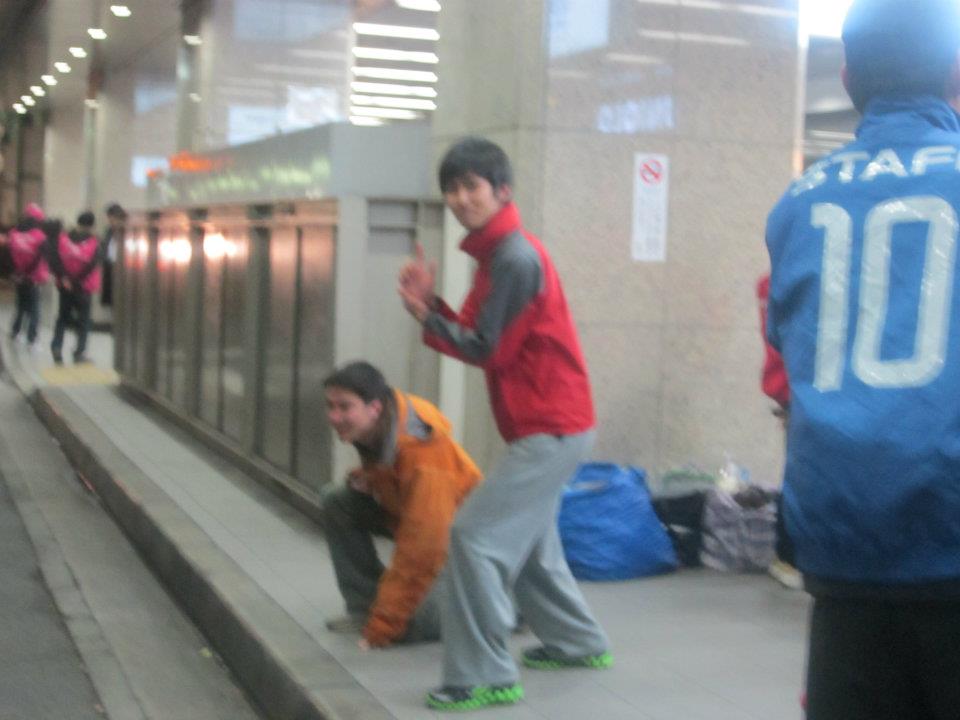
Preparing to see off some KCJSers on their way to Tokyo with Yoshi-kun (courtesy of Andrea Mendoza)
…and planked a little bit.

Vending Machines on the Road to Kameoka (courtesy of Yoshitaro Akiyama)
I started practicing parkour in the Gosho, on the street (not in anyone’s way of course), in my head, basically the same way as I would in the US, but with a renewed energy.
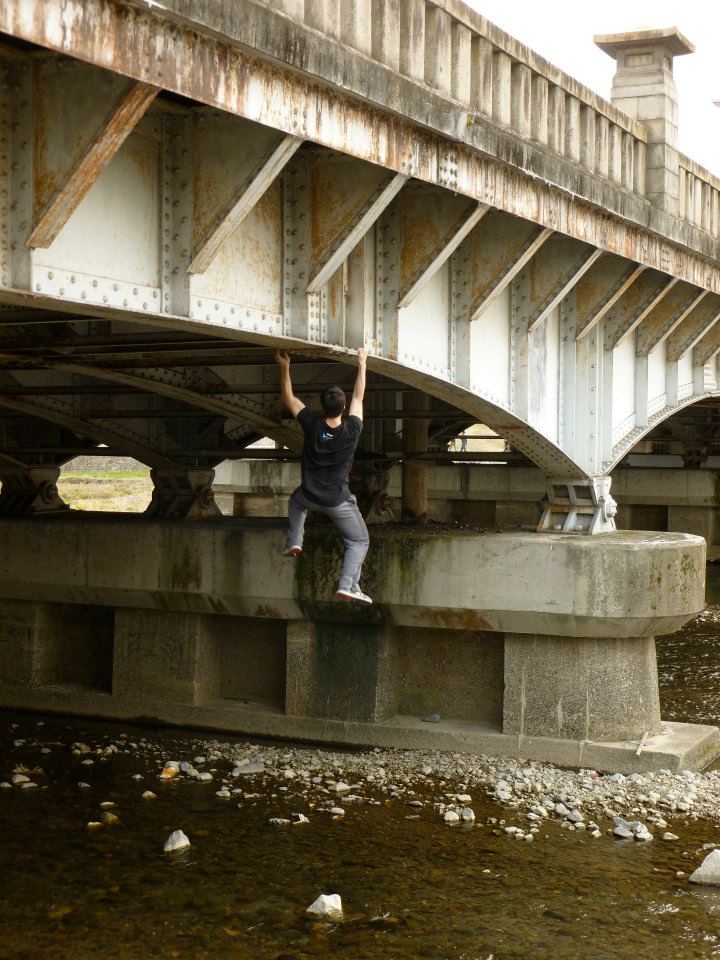
Imadegawa Parkour (courtesy of Lindsay Kosasa)
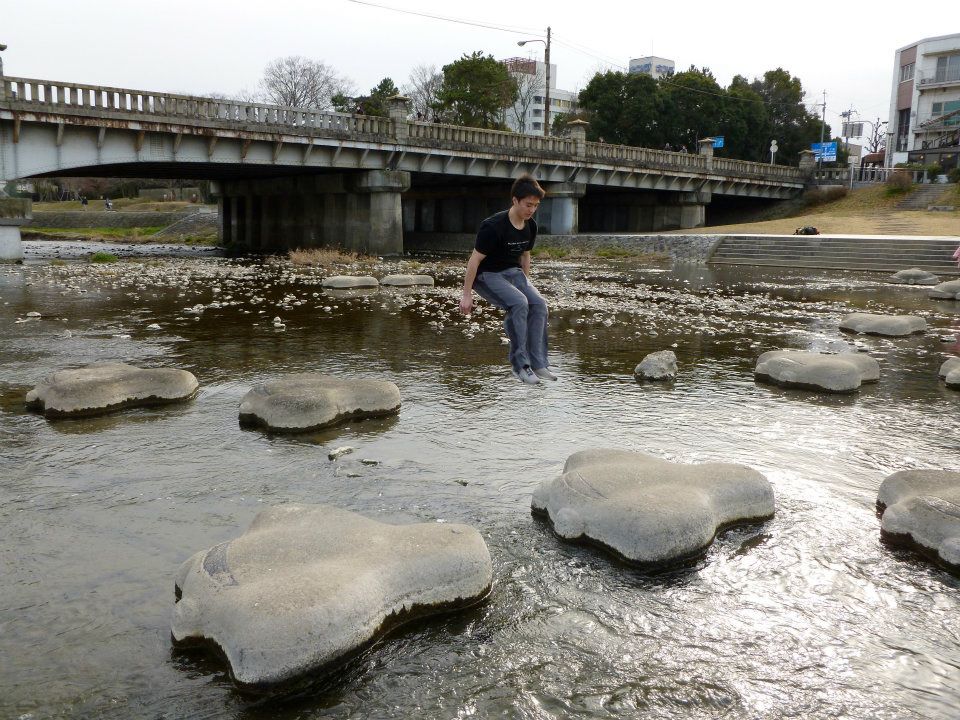
Kamogawa Parkour (courtesy of Lindsay Kosasa)
Don’t worry, I’m getting to the CIP part. Really.
I reminisced about drumline, brainstormed ideas for new pieces for the taiko group, and tried my best to learn as many of the songs as I could for the performance we had last month.
I think those first few days after I gave up on trying to become normal member of Japanese society also made clear how much I love movement, music and the amazingly welcoming groups that make me feel at home doing both here in Japan. Originally, I treated parkour jams and taiko practices as breaks from everyday life in Japan. Though this semester, through instead making those activities part of my daily life even when alone, and also through forcing Fukai-sensei to deal with my existential notebook assignments, I think I was able to find my place in this society. As far as parkour on my own and with the phenomenal Nagare Parkour, that means I became a member of a part of society that is healthy, strong, looking to improve itself, fun-loving, and for some reason doesn’t seem to blend in with the rest of Japan. In the case of the Kitanotenmangu Kamiwakakai Taiko Club (北野天満宮の神若会), I became a member of a family of families and hard working men and women who love people, music and being and playing together. While I don’t know at this point whether I have good reason to return to Japan for an extended period of time, I think I can say that I found a place to be in the groups that I sought out from the start. The goal of the Community Involvement Project (CIP) is to move beyond simply observing society and participate in it. I became a member of society not as a student, and not as someone who can pass as nikkei, but in the sense that I found two groups to belong to that I really love.
Last semester I wrote that I didn’t feel like a true member of the Kitanotenmangu taiko group. Well, that changed. It seems like almost all at once that a couple of the other KCJS students and I started going to dinner along with some members of the group after events sometimes, that it became easier to talk and even joke around a little bit, and that I started to feel like I was not only an exchange student (that was still obvious because we’re not allowed to pay for anything), but a real member of the group. On top of that, we learned new pieces for the performance we had last month, and one of the members who is a carpenter made bachi (taiko drum sticks) and handed them out to everyone. In other words, my first pair of bachi were hand made! The performance turned out to be a lot of fun, even though I was nervous because we sounded really messy at the last practice. The group is more focused on enjoying being and playing together than on playing perfectly, and I’d take that over a super strict group with a perfect sound any day.
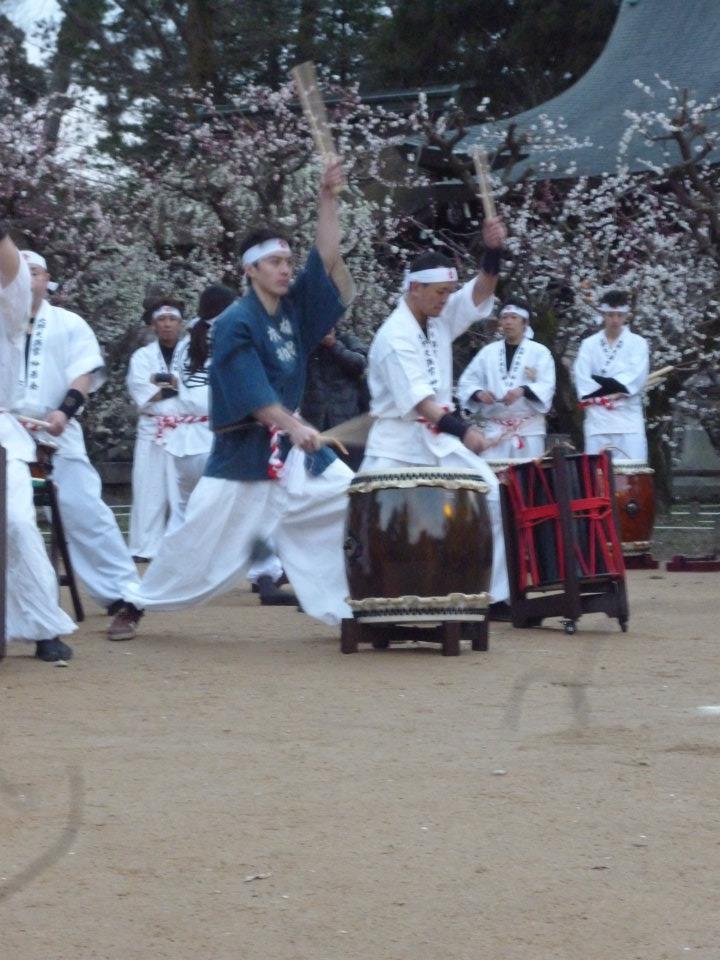
Me! (courtesy of Trisha Martin)
Fukai-sensei, Nishimata-sensei, Shore-san, and a bunch of other KCJS students came out to cheer us on at the performance (thanks guys!). The wonderful Nishimata-sensei was kind enough to take some video:
北野天満宮の紙若会:「座論梅」
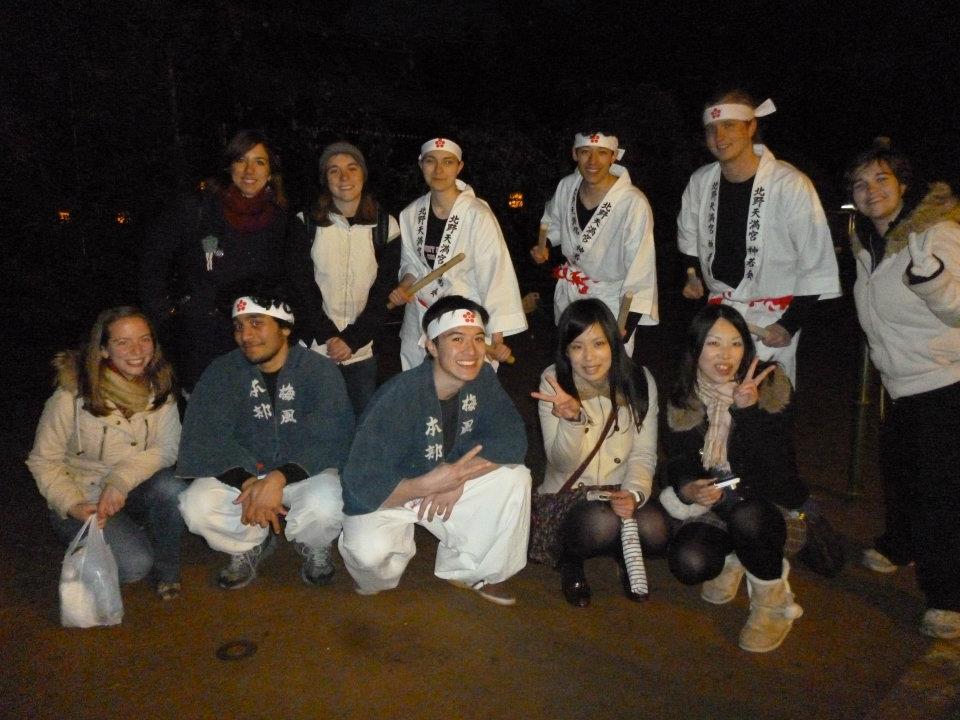
KCJS Group Photo After the Performance (courtesy of Trisha Martin)
Last semester, I wrote that I felt at home training with Nagare Parkour. Even so, I managed to learn some more names, meet more people from all over the place, and get more comfortable speaking with everyone. I also started going out to dinner with a group of members after jams. I might be seeing a pattern here… I do feel like I may focus a little more on the activity than on my relationship with the people overall and that could use some work. But I think that in both parkour and in taiko, I have made real friends that have influenced my life in positive ways. I think that I have been able to at least share common experience with them if not share some knowledge and I plan to keep in touch.
Anyway, one particular day after a post-parkour-jam dinner, everyone decided that they still wanted to train some more. So we began to goof around, took some pictures on a red carpet we found, headed to Shinsaibashi and trained until around 10pm, an unprecedented 9 hours of parkour related activity on a school night. I still had to take the train back to Kyoto so of course I didn’t get any of my schoolwork done (I tend to favor sleep/health over school), but it was worth it. It also just so happens that that day was a special day on which a YouTube project called “Japan in a Day” was taking place, so naturally we took a video to contribute. There’s not much actual parkour in the video, but it gives a sense of the flow and atmosphere of the day from the point of view of my friend, Tak:
3.11 Japan in a Day – “Parkour” (courtesy of Takafumi Kojima)
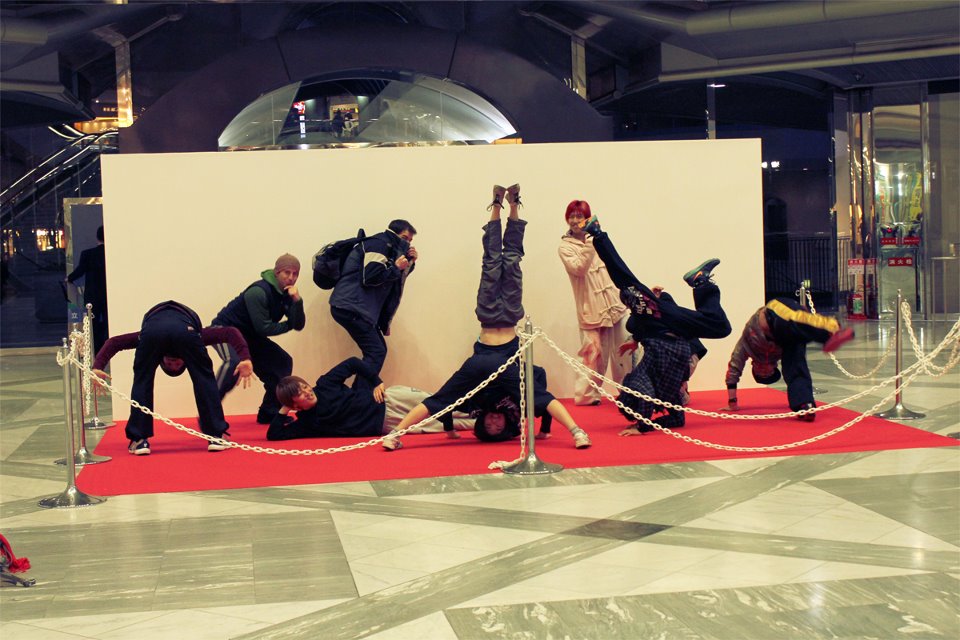
Post-dinner Group Picture (courtesy of Takafumi Kojima)
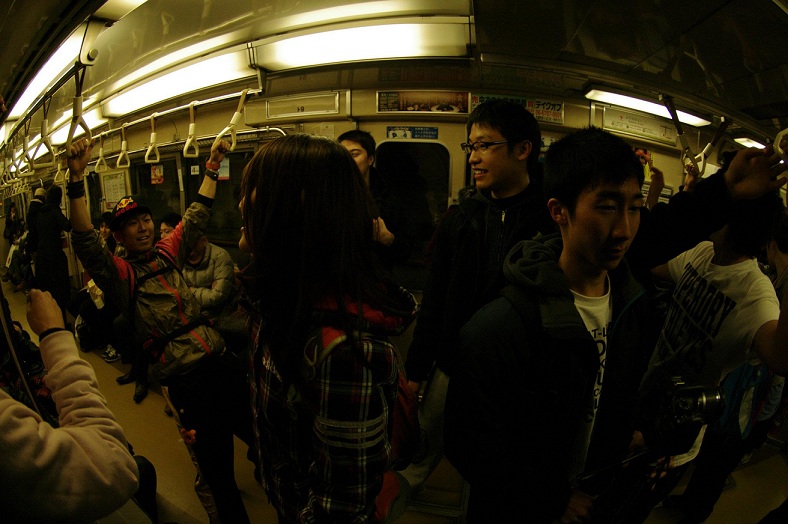
Enroute to Shinsaibashi with Nagare Parkour (courtesy of Bernardo Mayer)
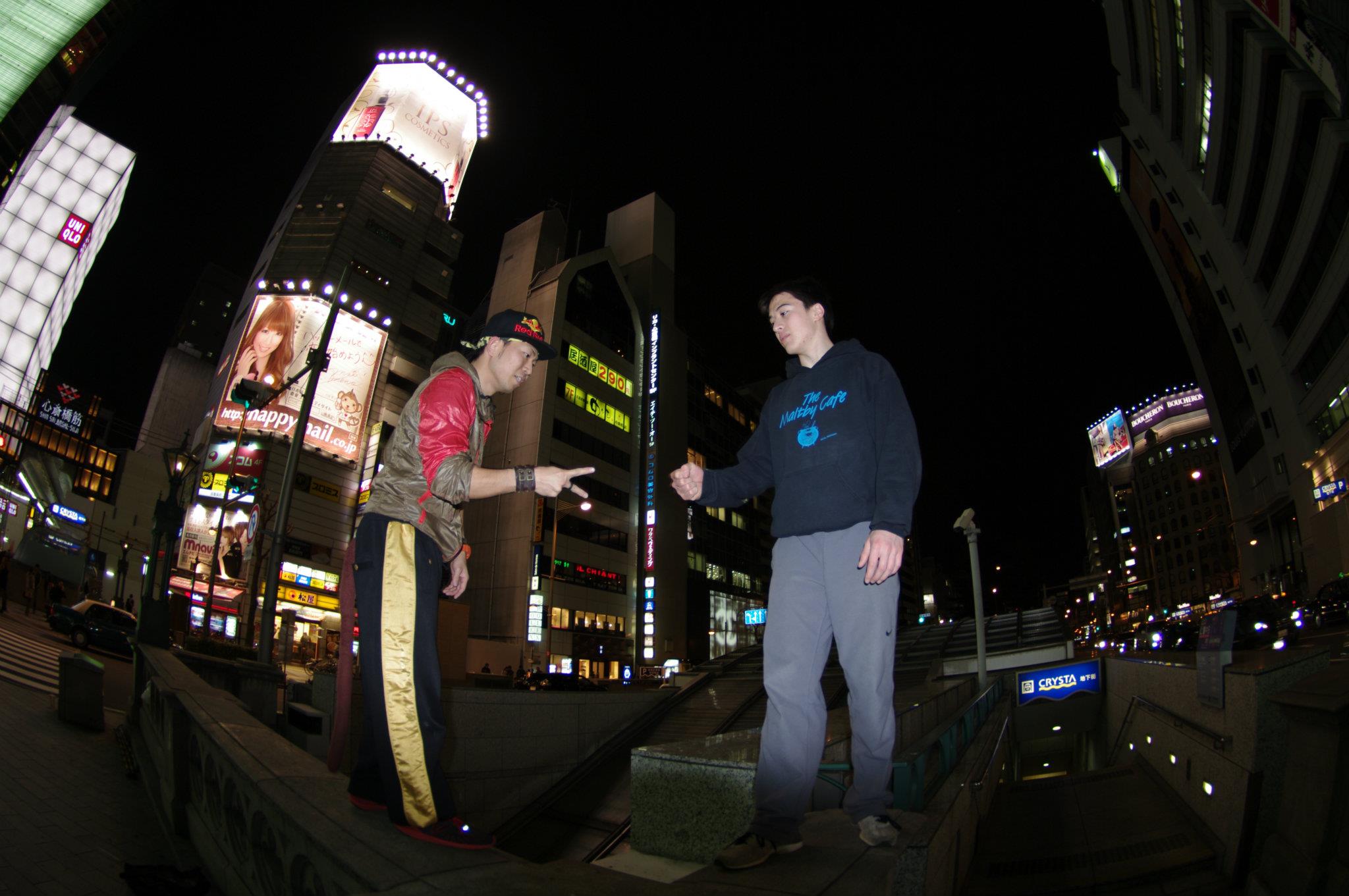
Jyan Ken Pon (courtesy of Bernardo Mayer)
On a more pragmatic note, I think this semester I was able to get more involved in both of my CIP activities not only for the reasons that I mentioned above, but simply because I was more in contact with the members of both groups. I ended up exchanging Facebook information with a couple of members in the taiko group, and a lot of people in the parkour group. I guess I was lucky that Facebook is gaining popularity here in Japan. For someone who was not originally a believer in social networks, I was surprised at how quickly and how much my relationship with some of the taiko members changed (in a good way). This is probably in part because we started to passively see into each other’s lives without actually speaking directly, and that’s really weird, but I guess it’s the world we live in. It’s also a topic for a whole different discussion. Anyway, I also Skype occasionally with a friend from parkour.
If there’s any advice I would give new exchange students (and myself if I were to go back in time), it would be to exchange contact information as soon as possible and to follow up with the people you want to get to know. If you’re in a group activity with peers or really friendly people that you’d like to get to know, there’s no reason not to be in contact a little bit more informally. Learning names and participating is one thing, but building a relationship requires contact, especially when everyone is so busy and lives so far apart (ばらばら).
That sounds obvious, right? Well, I guess the reason I mention it is because there have been plenty of times when I’ve exchanged contact information with Japanese students, acquaintances, etc., and those exchanges turned out to be almost meaningless. But the Community Involvement Project is one of the few opportunities we are presented with that force us to interact with people who are interested in things that we are, at more than surface-level. Because KCJS students are part of a program that is socially isolated from the rest of the university, and there are very few Japanese students in the afternoon classes, we have very little genuine interaction with other Japanese students. Hindsight is 20/20: Now I see that it’s important to take the opportunities that you are given to build real relationships, because no matter how many people you meet, friendships like others you have in the U.S. will not just magically happen if you don’t reach out.
Looking back, I feel that life in Japan would be awfully lonely without a group to belong to. Life here in between group interactions is a little bit lonely as it is, and I can’t quite put my finger on why. In any case, although I wish I was able to spend more time with them, I’m glad that I was able to find the two groups that I did. They gave me a place to be, and eventually became a big part of what it means for me to be in Japan.
I’ll close with another video: Kansai Parkour Family (courtesy of Takafumi Kojima)
(As a disclaimer to this, I would like to state that I am realizing a lot of this right now. And while I think I have found a place for myself in Japan, I could have done a lot better job actually experiencing being in that place. Meeting once every two weeks is simply put, not enough. If that kind of meeting schedule could provoke me to write all this, imagine what would happen if I had reached out and spent more time with everyone.)









